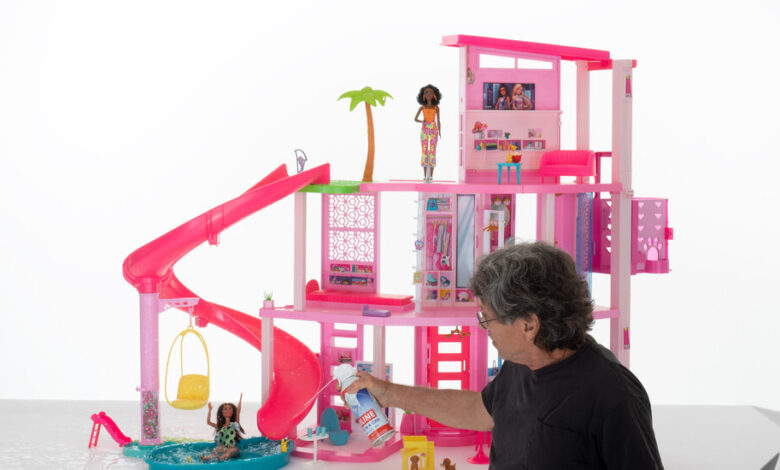Living in a Barbie World, Through the Decades

Times Insider explains who we are and what we do and delivers behind-the-scenes insights into how our journalism comes together.
One afternoon last summer, Anna Kodé, a reporter on the Real Estate desk at The New York Times, and Nikita Stewart, the desk’s editor, were talking about the upcoming “Barbie” film when, naturally, the conversation turned to Barbie’s personal pad, the Dreamhouse.
Ms. Kodé had long wanted to write about the dollhouse that had captured the imagination of many young Americans for decades.
“While people have really analyzed the social significance of Barbie, we hadn’t had that same conversation about the Dreamhouse,” Ms. Kodé said in an interview. “We wanted to spark that.”
So she began researching the history of the Dreamhouse and interviewing experts, including executives at Mattel, the makers of Barbie, as well as scholars in various fields. She wanted to understand how changes in society shaped versions of the Dreamhouse over the last 60-plus years.
The article, which was published this past week, documents the ways in which Barbie’s Dreamhouses reflect the social, cultural and economic evolution of modern American life. For example: In 1962, when Mattel released Barbie’s first Dreamhouse, financial institutions often denied mortgage applications from single women. Barbie’s ranch-style home was modest but all her own, and unlike dollhouses of decades past, it was not built around the idea of domestic roles — it didn’t even have a kitchen. By 1974, when the Equal Credit Opportunity Act was passed, banning credit discrimination, Barbie’s Dreamhouse got a glamorous upgrade to three stories.
Ms. Kodé wrote about this rich history, using Barbie’s Dreamhouses to mark different historical moments. Stop-motion animations accompany the text; each animation allows viewers to explore a Dreamhouse.
In May, Ms. Kodé, along with Tony Cenicola, a Times photographer; Michael Kolomatsky, a Real Estate editor; and Gabriel Gianordoli, an assistant editor for Digital News Design, purchased a Dreamhouse from 2000 on eBay and bought several Barbies at a flea market to take test photographs. Using the toys, they mapped out the art direction and lighting. But they also practiced moving and photographing Barbie using the stop-motion technique. By ever so slightly adjusting a pointed foot or a plastic arm, and repeating that effort around 100 times between frames, the journalists could make it appear as if Barbie were moving around the house.
Ms. Kodé reached out to Mattel to see if the team could have access to its headquarters in El Segundo, Calif. Mattel granted their request and provided over 20 archival Barbies and six Dreamhouses for their use.
The team visited Mattel in late May. They spent more than 18 hours over two days in a windowless studio, painstakingly arranging the Barbies in the Dreamhouses. (They went through a lot of wire and glue to keep Barbie in place.) Some Dreamhouses took over an hour to set up; the longest shoot required moving Barbie 137 times. Mr. Cenicola photographed each setup patiently; he was familiar with stop-motion, having previously used the technique in 2020 in an article about New York State’s ban on plastic bags.
The team wanted to capture moments that felt true to each era. In the house from 1962, Barbie is photographed playing a record. In the 1970s, a decade that experienced an environmental movement, she is pictured leaning over her plants.
“For each time period, we had Barbie do actions that spoke to that,” Ms. Kodé said. “In the section that touches on the sexual revolution, we wanted Ken to walk up to the house and give Barbie a rose.”
Though many scenes represented social trends, some also reflected how economic shifts affected the real estate market. For example, when the size of the average American house grew in the 1990s, Barbie got a (sparkly pink) McMansion. But the toys didn’t mirror every shift in the market: As Ms. Kodé noted, Barbie was spared from downsizing during times of economic downturn.
After visiting Mattel, Mr. Cenicola spent several days editing the photographs, removing items such as wires and adjusting slight variations in exposure and tone. Then he combined certain frames, adjusting the speed or alternating the action forward and backward, to give the appearance of movement.
While working with toys — even as adults — can be fun, the journalists approached the photo shoot with the understanding that there was an important story to be told.
“We were trying to strike a balance between it being a little fun but not being goofy because the tone of the story is very serious,” Mr. Gianordoli said. “It’s a history lesson.”
Assembling the Dreamhouses, Ms. Kodé said, is something she’ll never forget. Though she played with plenty of Barbies growing up, she said she never had her own Dreamhouse.
For articles, Ms. Kodé said, “I have tried on Joan Didion’s sunglasses. I have been to fashion shows. I’ve been to museum openings. But I had never played with toys for two full days in a row.”
Source link






